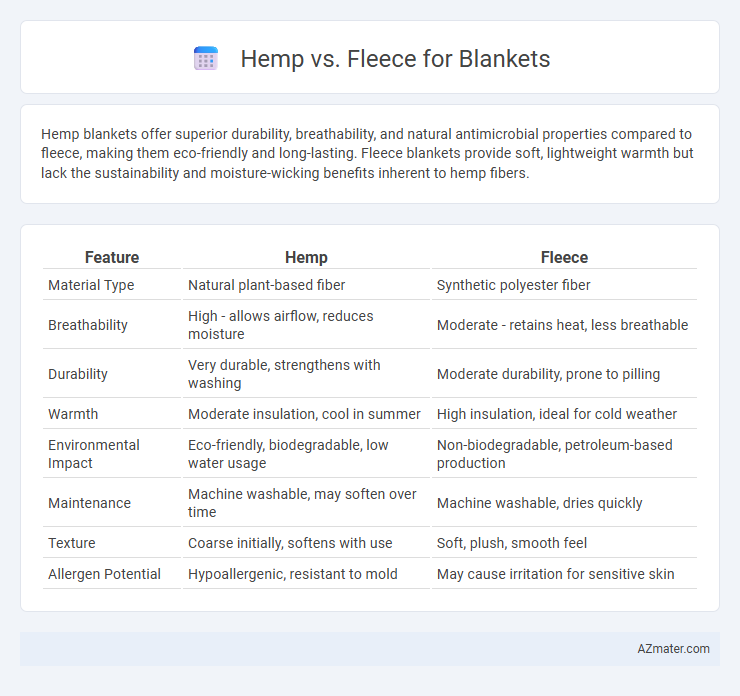Hemp blankets offer superior durability, breathability, and natural antimicrobial properties compared to fleece, making them eco-friendly and long-lasting. Fleece blankets provide soft, lightweight warmth but lack the sustainability and moisture-wicking benefits inherent to hemp fibers.
Table of Comparison
| Feature | Hemp | Fleece |
|---|---|---|
| Material Type | Natural plant-based fiber | Synthetic polyester fiber |
| Breathability | High - allows airflow, reduces moisture | Moderate - retains heat, less breathable |
| Durability | Very durable, strengthens with washing | Moderate durability, prone to pilling |
| Warmth | Moderate insulation, cool in summer | High insulation, ideal for cold weather |
| Environmental Impact | Eco-friendly, biodegradable, low water usage | Non-biodegradable, petroleum-based production |
| Maintenance | Machine washable, may soften over time | Machine washable, dries quickly |
| Texture | Coarse initially, softens with use | Soft, plush, smooth feel |
| Allergen Potential | Hypoallergenic, resistant to mold | May cause irritation for sensitive skin |
Introduction: Hemp vs Fleece Blankets
Hemp blankets offer exceptional durability, breathability, and natural antimicrobial properties, making them an eco-friendly choice for sustainable bedding. Fleece blankets, made from synthetic fibers, provide lightweight warmth and softness, excelling in insulation and quick-drying capabilities. Understanding the differences in material composition, environmental impact, and comfort levels helps consumers select the ideal blanket for their needs.
Material Origins and Sustainability
Hemp blankets are derived from the fibers of the Cannabis sativa plant, known for their durability and natural resistance to pests without heavy pesticides. Fleece blankets, typically made from polyester synthesized from petroleum, rely on non-renewable fossil fuels and involve energy-intensive manufacturing. Hemp's biodegradable nature and rapid growth cycle position it as a more sustainable option compared to synthetic fleece that contributes to microplastic pollution.
Environmental Impact Comparison
Hemp blankets have a significantly lower environmental impact compared to fleece blankets due to hemp's rapid growth, minimal water requirements, and natural resistance to pests which reduces the need for pesticides. Fleece, often made from petroleum-based polyester, contributes to microplastic pollution and relies on non-renewable resources, increasing its ecological footprint. Choosing hemp blankets supports sustainable agriculture and reduces plastic waste, making it a more eco-friendly option for environmentally conscious consumers.
Softness and Comfort Levels
Hemp blankets offer natural breathability and durability but are generally coarser compared to fleece, making them less soft initially. Fleece blankets provide superior softness and warmth due to their synthetic fibers, creating a cozy and comfortable feel ideal for cold weather. While hemp softens with use and provides excellent moisture-wicking properties, fleece remains the preferred choice for immediate plush comfort and gentle touch on the skin.
Durability and Longevity
Hemp blankets offer exceptional durability due to their strong natural fibers, resisting wear and tear far better than fleece. Fleece blankets, made from synthetic polyester, tend to pill and degrade faster with frequent washing, reducing their longevity. Hemp's antimicrobial properties and resistance to UV light contribute to blankets that maintain quality and strength over many years.
Warmth and Insulation Properties
Hemp blankets offer excellent breathability and moisture-wicking properties, providing moderate warmth while preventing overheating, ideal for temperate climates. Fleece blankets excel in insulation due to their dense synthetic fibers, trapping body heat effectively to deliver superior warmth in cold environments. Choosing between hemp and fleece depends on the desired balance of natural moisture control and maximum thermal insulation.
Care and Maintenance Differences
Hemp blankets require minimal maintenance, as they are naturally resistant to bacteria and mold, making them ideal for easy care; they can be machine washed in cold water and dried on low heat without significant wear. Fleece blankets demand more careful washing to maintain their softness and prevent pilling, typically requiring gentle cycles and avoiding high-heat drying or fabric softeners. Hemp's durability improves with each wash, while fleece's synthetic fibers may degrade over time with improper care.
Allergens and Skin Sensitivity
Hemp blankets naturally resist allergens due to their antimicrobial properties, making them ideal for sensitive skin and allergy sufferers. Fleece blankets, while soft and warm, can sometimes trap dust mites and irritants, potentially aggravating sensitive skin or allergies. Choosing hemp ensures breathability and hypoallergenic comfort, reducing the risk of skin irritation and allergic reactions.
Cost and Value Analysis
Hemp blankets typically offer higher upfront costs due to durable, eco-friendly fibers and sustainable production methods, while fleece blankets are more affordable and widely available. Despite the initial price difference, hemp blankets provide greater long-term value through superior breathability, moisture-wicking properties, and enhanced longevity, reducing the need for frequent replacements. Evaluating cost against durability and environmental impact highlights hemp as a cost-effective, sustainable investment compared to budget-friendly but less durable fleece.
Choosing the Right Blanket for You
Hemp blankets offer durability, breathability, and natural antibacterial properties, making them ideal for those seeking sustainable and hypoallergenic options. Fleece blankets provide superior warmth and softness, perfect for cold climates or cozy indoor settings. Choosing the right blanket depends on your preference for eco-friendly materials versus plush comfort and temperature regulation.

Infographic: Hemp vs Fleece for Blanket
 azmater.com
azmater.com